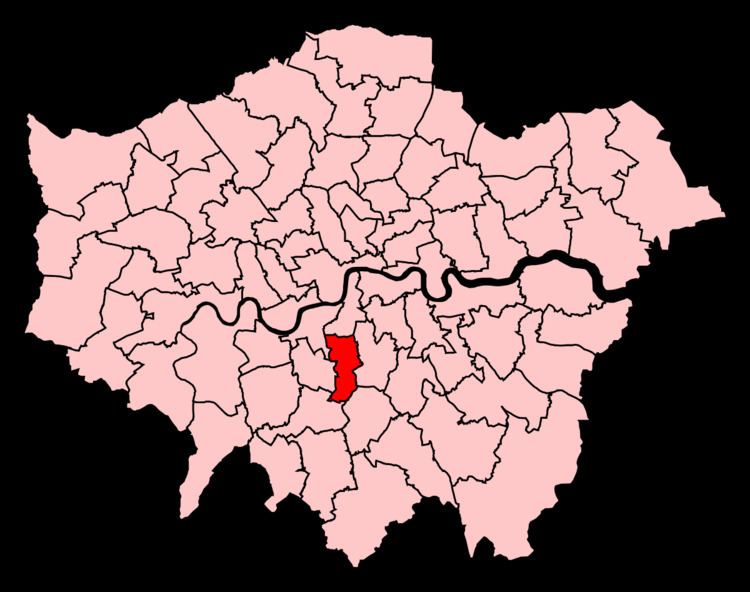County Greater London Created 1918 Number of members One | Electorate 71,913 (December 2010) Member of parliament Chuka Umunna (Labour) Created from Wandsworth | |
 | ||
Streatham is a constituency created in 1918 represented in the House of Commons of the UK Parliament since 2010 by Chuka Umunna, a Labour Party MP.
Contents
Boundaries
1918-1974: The Metropolitan Borough of Wandsworth ward of Streatham.
1974-1983: The London Borough of Lambeth wards of Clapham Park, St Leonard's, Streatham South, Streatham Wells, and Thornton.
1983-1997: As above plus Streatham Hill, and Town Hall.
1997-2010: As above plus St Martin's, and Tulse Hill.
2010-present: The London Borough of Lambeth wards of Brixton Hill, Clapham Common, St Leonard’s, Streatham Hill, Streatham South, Streatham Wells, Thornton, and Tulse Hill.
Streatham is a long constituency comprising the south-west portion of the London Borough of Lambeth. The town of Streatham constitutes the four wards in the southern half of the constituency. At its north-western tip the seat includes half of Clapham Common; the north-east takes in part of Brixton which is shared with neighbouring Vauxhall and Dulwich and West Norwood.
The northern boundary follows Clapham Park Road, Acre Lane, and Coldharbour Lane through Clapham and Brixton to Lambeth Town Hall. The north-eastern boundary generally follows Effra Road and Tulse Hill, but runs east of the main road to include the part of the Tulse Hill estate and the Cressingham Gardens estate west of Brockwell Park. The boundary skirts the Tulse Hill district centre, following Hardel Rise, Christchurch Road and Norwood Road, and then runs along Leigham Vale and Leigham Court Road. The southern and western constituency boundaries follow Lambeth's borough boundaries with Croydon, Merton and Wandsworth.
History
The constituency of Streatham was contested under the name at the 1918 general election when it approximately followed the historic parish boundaries of Streatham, including a substantial part of Balham, a 19th century founded primarily urban parish by 1918.
The constituency was carved out of the former constituency of Wandsworth in the same way as Putney, Wandsworth Central and Balham and Tooting under the Representation of the People Act 1918, the fourth major UK reform, that settled upon single member constituencies, and roughly equal electorates.
The 1918 boundaries remained unchanged until the 1965 changes to Greater London local government became reflected in the parliamentary constituencies, at the February 1974 general election. This resulted in a net reduction in the size of the area. The western district Streatham Park (location of the Streatham Conservative Club) and the remainder of Furzedown ward went into Tooting.
The rest of the constituency, including the town of Streatham has since 1965 been in the London Borough of Lambeth. Three other constituencies covered Lambeth from 1974, Vauxhall, Norwood and Lambeth Central. The Clapham constituency was abolished as part of the 1974 changes. The Clapham Park area and Hyde Farm (commonly thought of as part of Balham) came into the Streatham seat, whereas the rest of Clapham went into the Vauxhall seat creating a enduring split.
On abolition of Lambeth Central at the 1983 election, the constituency gained much of southern Brixton. Following further population decline, Lambeth was paired with Southwark in the next boundary review, and from the 1997 election, Streatham constituency gained areas around Tulse Hill from the former Norwood constituency, the rest of which became part of Dulwich and West Norwood.
Streatham was for a few decades solidly Tory suburbia overall - the Conservatives won Streatham when Labour gained large majorities in 1945 and 1966, and it was the only seat in the former LCC area (Inner London) apart from the Chelsea/Kensington/Westminster/City central core to remain consistently Conservative.
The Conservative Party lost Streatham in 1992 having held it since 1918. The Conservative candidate was beaten into third place by a Liberal Democrat in 2001, and there were swings from Labour to the Liberal Democrats at the two subsequent general elections. An improvement in the Conservative share of the vote took place in 2010, when the Labour incumbent, Keith Hill, retired and Chuka Umunna was elected standing with the party. The 2015 result was the re-election of Umunna, which made the seat the 96th safest of Labour's 232 seats by percentage of majority.
Streatham has swung heavily against the Conservative Party since the 1980s, even more than other similar seats in South London (such as Croydon North, Dulwich, Lewisham East and West). Demographic and voting pattern changes combined with unfavourable boundary changes converted Streatham into a marginal seat, then into a mid-ranking safe Labour seat.
Constituency profile
Among the most ethnically diverse constituencies, Streatham - which covers parts of Clapham, Balham, Brixton, Tulse Hill and Streatham - is in the south London borough of Lambeth. Only 58.2% of residents are white and it has among the most mixed race and black residents in the country, according to the 2011 Census. It has Polish, Portuguese and Hispanic communities. The bulk of residents are aged 25-44, with relatively few pensioners.
Although it is a residential area, it is more popular with young workers than families - with good transport links into central London. Many residents rent and there is a large social housing sector. Streatham High Road is home to over 400 businesses. A £26m ice rink and leisure centre opened in November 2013, part of continuing investment. The population is highly qualified and a high percentage are in full-time work. Labour's Chuka Umunna won this seat in 2010 - with a 3,259 majority. The Lib Dems came second.
A key issue that was a deciding factor of the election was Cressingham Gardens. The Greens, Conservatives and UKIP were all opposed to the demolition of the 306 dwellings. Excluding the 3 Conservative Opposition Councillors, 2 Labour Councillors (out of the 59) and 1 Green Councillor, the entire council supported the demolition. Chuka Umunna was against the demolition, along with Kate Hoey.
Elections in the 2010s
NB Percentage comparions in the table above are against the notional result on the new constituency boundaries.
